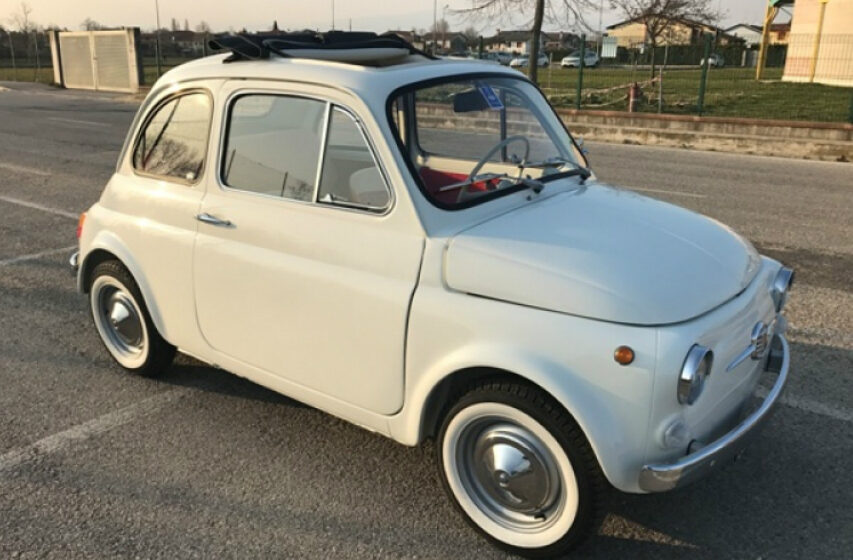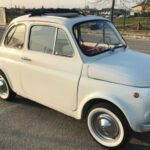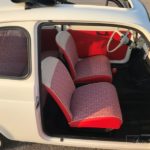Fiat 500 F
Year: 1968
White color with red interiors, emblem of Italy all over the world!
It is possible to use the “Courtesy Service”, which consists of:
- Delivery and collection of the car on site.
- Our assistance staff for the entire duration of the rental.
- Fuel consumption.
- Rental without driver.
Rental Requirements:
- At least 25 years
- 5 years of driving license
- Credit card guarantee (pre-authorization) and / or check at the discretion of the Charterer
A bit of history of this car:
In 1965 the New 500 F was presented, heir to the “D”, destined to become over the years the version with the largest number of units built. The innovations are above all aesthetic: the most evident inversion in the opening of the doors, hinged with 8 screws per door from which the term “eight bolts” that distinguishes the first F from March 1965 until January 1966, or with chassis number just over one million (this version is very sought after today due to a production lasting only “10 months”) where it will then go on to the classic hinging with 4 screws per door.
This change, in 1965, was due to the Highway Code which imposed the hinging of the front doors for all models, for greater safety. The FIAT therefore also adapted the 500 sedan, but not the Giardiniera, which maintained the unchanged opening throughout the production (until 1977), as the Code provided an exemption for commercial vehicles. It is also the beginning of the plastic era, which replaces numerous sheet metal and metal parts. The bodywork is reviewed much more than it seems by the inversion of the doors. In practice, only the bonnet and the front part remain of the 500 D shell. Other important details also change: the windscreen is wider and offers greater visibility; the roof is built in one piece with the uprights and no longer bolted to the columns; the front frieze of the mask is made of a single piece of plastic (from 1966) and no longer has the separate aluminum mustache; the door handles are chromed and their shape is suitable for the new type of opening; the wheel covers (or cups) are in steel (since 1967) and no longer in polished aluminum; the headlights have chromed metal frames (since 1966) instead of aluminum and use asymmetrical beam projectors; the position lights lose the aluminum bases like the rear lights, now of a more squared shape; the hood closes with a single black plastic central hook instead of the two small metal hooks located on the two sides of the roof; the aluminum profile on the front bonnet and the moldings on the sides are eliminated; the three dashboard switches (lights, panel lighting, windscreen wipers) are aligned along the dashboard; the glove pocket is made of plastic and has larger dimensions; the tank is no longer an onion but a half cylinder and its capacity rises to 22 liters; the license plate light is plastic (since 1966).
The engine is still revised in the timing and delivers 18 hp. The suspensions are strengthened and the axle shafts are larger in diameter. The braking system is also upgraded and adopts larger cylinders. Initially, the 500 F adopts some pieces of the old D, waiting for the equipment of new details and to exhaust the old stock of FIAT (something quite common at the time). Until July 1965, in fact, it still mounts the front direction indicators with aluminum base and the front seats with elastic bands that will then be replaced by those with springs. In the summer of 1966 (up to Chassis 1,211,123) the muffler is no longer as a drip like on the D, but with overlapping half-shells (recognizable by the rounded ends) and the plate light is made of plastic and no longer polished aluminum. Until the last months of 1966 the windshield wipers are still “tight”, and the small castle on the starter air linkage tunnel is bolted with 2 screws (which will become one). The engine air grille is initially 6 screws and then moved to 3 between March and April 1966. There was therefore a small interserie called “6 screws” produced for about 3 months (January – April ’66) with hinged doors “4 bolts” and 6 screws air grille. In October 1968 some changes appear to coincide with the arrival of the “L” version that will support it.
The writing “Nuova 500” disappears on the rear bonnet and a horizontal plate appears, with bars, with the inscription “Fiat 500” and the seats lose the beige top bezel and become a solid color. Since February 1970 the license plate light (as on the L) is moved higher. The production continues in parallel with that of the L until November 1972, when the latest version of the “small big car” is marketed, the 500 R.










